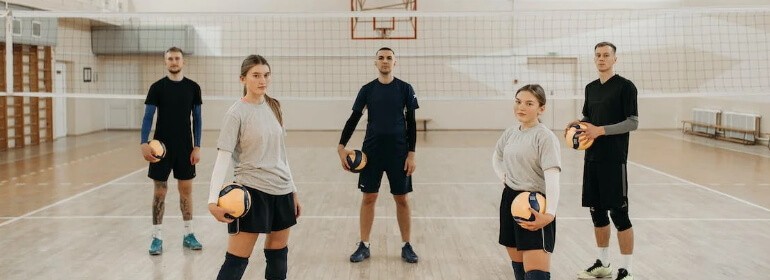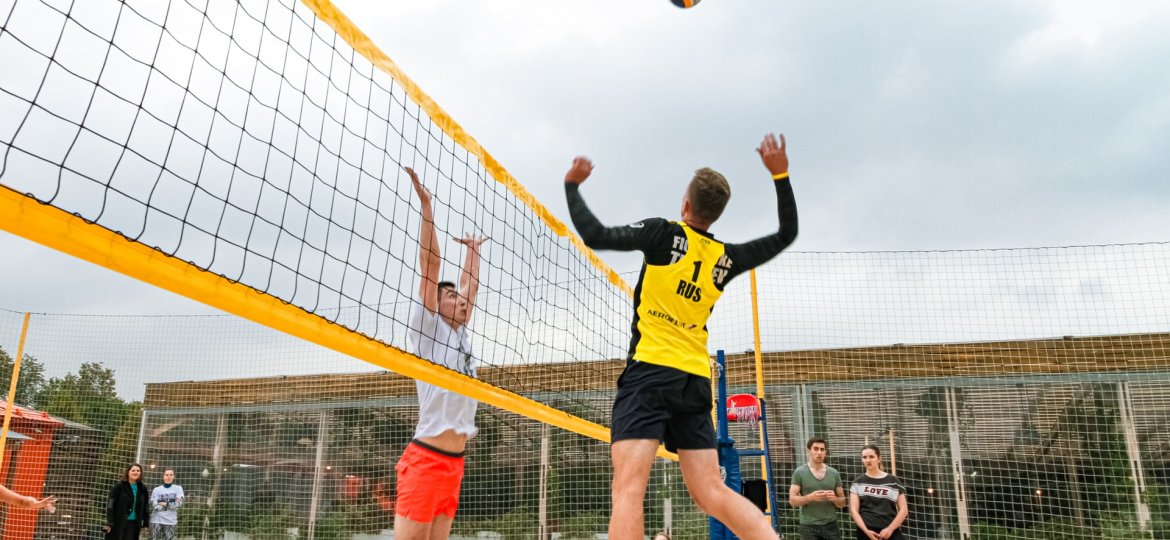
Volleyball
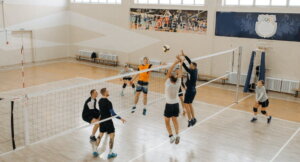
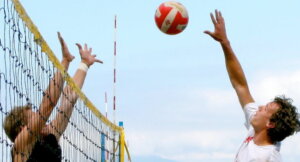
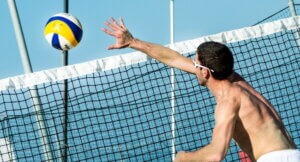
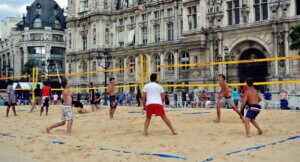
Volleyball is a thrilling and widespread sport that attracts a diverse range of people worldwide, regardless of their age or abilities. It requires a combination of physical and mental skills, including strength, speed, coordination, strategy, communication, and teamwork. Volleyball is a team sport played by two teams of six players on a court separated by a net. The aim is to score points by sending the ball over the net and preventing it from hitting the ground on the opposing team’s side of the court.
Volleyball is a thrilling and widespread sport that attracts a diverse range of people worldwide, regardless of their age or abilities. It requires a combination of physical and mental skills, including strength, speed, coordination, strategy, communication, and teamwork. Volleyball is a team sport played by two teams of six players on a court separated by a net. The aim is to score points by sending the ball over the net and preventing it from hitting the ground on the opposing team’s side of the court.
Volleyball is a thrilling and widespread sport that attracts a diverse range of people worldwide, regardless of their age or abilities. It requires a combination of physical and mental skills, including strength, speed, coordination, strategy, communication, and teamwork. Volleyball is a team sport played by two teams of six players on a court separated by a net. The aim is to score points by sending the ball over the net and preventing it from hitting the ground on the opposing team’s side of the court.
Volleyball is a thrilling and widespread sport that attracts a diverse range of people worldwide, regardless of their age or abilities. It requires a combination of physical and mental skills, including strength, speed, coordination, strategy, communication, and teamwork. Volleyball is a team sport played by two teams of six players on a court separated by a net. The aim is to score points by sending the ball over the net and preventing it from hitting the ground on the opposing team’s side of the court.
Volleyball is a thrilling and widespread sport that attracts a diverse range of people worldwide, regardless of their age or abilities. It requires a combination of physical and mental skills, including strength, speed, coordination, strategy, communication, and teamwork. Volleyball is a team sport played by two teams of six players on a court separated by a net. The aim is to score points by sending the ball over the net and preventing it from hitting the ground on the opposing team’s side of the court.
Volleyball is a thrilling and widespread sport that attracts a diverse range of people worldwide, regardless of their age or abilities. It requires a combination of physical and mental skills, including strength, speed, coordination, strategy, communication, and teamwork. Volleyball is a team sport played by two teams of six players on a court separated by a net. The aim is to score points by sending the ball over the net and preventing it from hitting the ground on the opposing team’s side of the court.
Volleyball is a thrilling and widespread sport that attracts a diverse range of people worldwide, regardless of their age or abilities. It requires a combination of physical and mental skills, including strength, speed, coordination, strategy, communication, and teamwork. Volleyball is a team sport played by two teams of six players on a court separated by a net. The aim is to score points by sending the ball over the net and preventing it from hitting the ground on the opposing team’s side of the court.
Volleyball is a thrilling and widespread sport that attracts a diverse range of people worldwide, regardless of their age or abilities. It requires a combination of physical and mental skills, including strength, speed, coordination, strategy, communication, and teamwork. Volleyball is a team sport played by two teams of six players on a court separated by a net. The aim is to score points by sending the ball over the net and preventing it from hitting the ground on the opposing team’s side of the court.
Volleyball is a thrilling and widespread sport that attracts a diverse range of people worldwide, regardless of their age or abilities. It requires a combination of physical and mental skills, including strength, speed, coordination, strategy, communication, and teamwork. Volleyball is a team sport played by two teams of six players on a court separated by a net. The aim is to score points by sending the ball over the net and preventing it from hitting the ground on the opposing team’s side of the court.
Volleyball is a thrilling and widespread sport that attracts a diverse range of people worldwide, regardless of their age or abilities. It requires a combination of physical and mental skills, including strength, speed, coordination, strategy, communication, and teamwork. Volleyball is a team sport played by two teams of six players on a court separated by a net. The aim is to score points by sending the ball over the net and preventing it from hitting the ground on the opposing team’s side of the court.
Volleyball is a thrilling and widespread sport that attracts a diverse range of people worldwide, regardless of their age or abilities. It requires a combination of physical and mental skills, including strength, speed, coordination, strategy, communication, and teamwork. Volleyball is a team sport played by two teams of six players on a court separated by a net. The aim is to score points by sending the ball over the net and preventing it from hitting the ground on the opposing team’s side of the court.
The roots of Volleyball can be traced back to 1895, when William G. Morgan, a physical education instructor in Massachusetts, invented the game. Volleyball has since evolved into a highly competitive and dynamic sport played at both amateur and professional levels worldwide. Today, the International Volleyball Federation (FIVB) is the governing body responsible for setting the rules and regulations of the sport and organizing international competitions.
Volleyball requires a high level of physical fitness and athleticism. Players must have the ability to jump, reach, and move quickly to play the game effectively. It also demands a strong sense of teamwork, as players must work together to communicate, cover the court, and execute a strategic game plan. Volleyball also necessitates a high level of mental focus and concentration, as players must be able to read the game and anticipate their opponents’ movements.
There are various styles of Volleyball, including indoor and outdoor Volleyball, beach Volleyball, and adaptive Volleyball for individuals with disabilities. Regardless of the style, Volleyball offers players a fun and engaging experience that enables them to develop their physical, mental, and social skills. Moreover, Volleyball is a sport enjoyed by fans worldwide and is often played in the spirit of fair play and sportsmanship.
Indoor Volleyball, which is the most popular form of Volleyball, is played on a court that is 18 meters long and 9 meters wide, divided into two halves by a net that stands 2.43 meters high for men and 2.24 meters high for women. Each team comprises six players, with three players in the front row and three players in the back row. The front-row players are responsible for attacking and blocking, while the back-row players are in charge of receiving and digging.
A rally begins with a serve, with the server hitting the ball from behind the end line and over the net to the opposing team’s side of the court. The receiving team must then return the ball by hitting it no more than three times to get it over the net and into the opposing team’s court. The objective is to make the ball hit the ground on the opposing team’s side or to force them to commit an error, resulting in a point for the serving team.
Beach Volleyball is played on a sand court with two players on each team. The court is 16 meters long and 8 meters wide, divided by a net that stands 2.43 meters high for men and 2.24 meters high for women. The game follows the same rules as indoor Volleyball, with the objective being to score points by preventing the ball from touching the ground on your side of the court.
Adaptive Volleyball is a variation of Volleyball designed for individuals with disabilities. It is played with modified rules and equipment, such as lower nets and larger balls, to enable players to compete at their best. The game offers people with disabilities an opportunity to engage in physical activity, develop their skills, and enjoy the sport.
Volleyball is an excellent way to develop physical fitness and athleticism. It is a high-intensity workout that improves muscle strength, cardiovascular endurance, agility, and coordination. Volleyball requires players to jump, reach, and move quickly, improving their speed, power, and endurance.
One of the most notable aspects of volleyball is that it is a versatile sport. Not only can it be played in various settings and with different numbers of players, but it can also be played by people of all ages and abilities. Volleyball is a popular activity in schools and community organizations, and is also enjoyed by recreational players at parks and beaches around the world.
The physical demands of volleyball require players to have a strong and fit body. Volleyball players must have good cardiovascular endurance to sustain the energy required to jump, run, and move quickly throughout the game. They must also possess good flexibility and coordination, as well as strength and power in their legs, arms, and core muscles. Proper nutrition and hydration are also important for volleyball players to maintain their stamina and physical performance during games.
Mental skills are also crucial for volleyball players. The fast-paced and dynamic nature of the sport demands that players be able to think quickly and make split-second decisions. Volleyball players must be able to read the game, anticipate their opponent’s moves, and adjust their own strategies accordingly. Communication skills are also important in volleyball, as players need to be able to communicate effectively with their teammates to coordinate their movements and execute their game plan.
Volleyball is also a sport that promotes teamwork and social interaction. Because the game is played with a team of six players on each side, players must work together to cover the court and achieve their objectives. This requires a high level of trust and cooperation, and players must be willing to support each other both on and off the court. Volleyball can also be a great way to meet new people and build friendships, as players often play in local leagues and participate in social events with other players.
The popularity of volleyball has led to the development of various organizations and competitions around the world. The International Volleyball Federation (FIVB) is the governing body for the sport, and is responsible for organizing major international tournaments, including the Volleyball World Cup, World Championship, and Olympic Games. Many countries also have their own national federations that oversee volleyball competitions at the domestic level.
One of the most popular variations of volleyball is beach volleyball. This style of the game is played on sand, with two players on each side instead of six. Beach volleyball has gained widespread popularity in recent years, and is now an Olympic sport in its own right. The sport requires a different set of skills than indoor volleyball, as the sand creates an unstable playing surface and players must contend with factors such as wind and sun glare.
In addition to beach volleyball, there are many other variations of the game that cater to specific needs and abilities. For example, sitting volleyball is a variation of the sport that is designed for individuals with disabilities. The game is played on a smaller court, and players are allowed to sit on the ground while playing. Sitting volleyball is a popular Paralympic sport, and has helped to promote inclusivity and accessibility in volleyball.
Volleyball is also a sport that can have a positive impact on physical and mental health. Regular participation in volleyball can help to improve cardiovascular health, build muscle strength and endurance, and promote flexibility and coordination. The social and teamwork aspects of the sport can also have a positive impact on mental health, helping to reduce stress and improve mood.
Volleyball gear
Volleyball is an exciting sport that requires specific gear and equipment to play. Proper Volleyball gear ensures that players are safe, comfortable, and perform their best on the court. Here is a detailed list of essential Volleyball gear and accessories.
Volleyball: The ball is the most crucial equipment in Volleyball. The official Volleyball is usually made of leather or synthetic materials and must meet specific size and weight requirements. It is designed to have a standard size of 65-67 cm in circumference, a weight of 260-280 grams, and a pressure of 0.30-0.325 kg/square cm. Volleyballs come in different colors and designs, and some balls are designed for specific types of play, such as indoor or beach Volleyball.
Net: The net is a barrier that separates the two teams and is used to determine if a ball is in or out of bounds. The official height of the net is 2.43 meters for men and 2.24 meters for women. The width of the net should be 9.5 meters for men and 9 meters for women.
Court: The court is the playing surface for Volleyball and is usually made of hardwood or synthetic materials. The standard size of the Volleyball court is 18 meters long and 9 meters wide. The court is divided into two sides by the net, with each side measuring 9 meters by 9 meters. There are boundary lines on the court that determine whether the ball is in or out of bounds.
Antennas: Antennas are used to indicate the boundary lines and to determine if a ball hits the antenna, it is considered out of bounds. The antennas are 1.8 meters long and are attached to the net, approximately 80 cm above the court. They are made of flexible fiberglass or similar materials.
Shoes: Volleyball shoes are specifically designed for the sport and provide support, stability, and grip on the court. These shoes have non-marking soles, which prevent them from leaving marks on the court. Volleyball shoes are made of lightweight and breathable materials that allow players to move freely on the court. They have a low profile that provides better stability and balance.
Kneepads: Kneepads are used to protect the knees during diving and floor play. Volleyball players spend a significant amount of time on the floor, and kneepads provide cushioning and protection against injuries. Kneepads are available in different sizes and materials, such as foam, gel, and neoprene.
Jersey: Jerseys are worn by players to distinguish between teams and often feature team colors and logos. Volleyball jerseys are typically sleeveless or have short sleeves, allowing players to move freely on the court. They are made of lightweight and breathable materials, such as polyester and spandex.
Shorts: Shorts are worn by players to provide comfort and mobility during play. Volleyball shorts are typically made of stretchy and breathable materials, such as spandex and nylon. They have a snug fit that allows players to move freely on the court without restrictions.
Ball pumps: Ball pumps are used to inflate and maintain the proper air pressure in the ball. It is essential to have the correct air pressure in the ball to ensure consistent performance and prevent injury.
Scorekeeper’s stand: The scorekeeper’s stand is used to keep track of the score during the game. It is usually a tall and narrow structure that is placed at the edge of the court. The scorekeeper sits or stands behind the stand and updates the score after each point.
In addition to the basic Volleyball gear, there are also several other accessories that can enhance the playing experience and improve performance.
Ankle braces are another important accessory in volleyball, as they support the ankles and reduce the risk of injury during play. Shin guards and elbow pads are also used to protect the shins and elbows during diving and floor play, respectively.
In addition to the basic gear and accessories, there are also several training aids that can be used to improve skills and performance in Volleyball. Some of these training aids include:
Resistance bands: Resistance bands are used to strengthen the muscles used in Volleyball, such as the legs, arms, and shoulders.
Jump training equipment: Jump training equipment is used to improve vertical jumping ability, which is important in Volleyball for both offensive and defensive play.
Blocking aids: Blocking aids are used to practice blocking techniques and improve timing.
Spike training aids: Spike training aids are used to practice hitting techniques and improve power and accuracy.
Setting aids: Setting aids are used to practice setting techniques and improve accuracy and consistency.
Volleyball machines: Volleyball machines are used to simulate game situations and provide repetitive training for various skills, such as serving, hitting, and setting.
In addition to gear and training aids, nutrition and hydration are also important factors in Volleyball performance. Players need to maintain a balanced and nutritious diet to fuel their bodies for optimal performance on the court. Hydration is also important, as players need to replenish fluids lost through sweat during long games and practices. It is recommended that players drink water before, during, and after games and practices to stay hydrated.
Training
To excel in Volleyball, a player must invest time in training and practice. Volleyball training typically involves a combination of physical and technical drills, as well as scrimmage play and game-like situations. The goal of training is to improve a player’s skills and performance, both physically and mentally.
Physical training is an important aspect of Volleyball training, as it helps players build strength, endurance, and agility. Strength training, such as weight lifting, can help players build muscle and improve their overall fitness. Cardiovascular training, such as running or cycling, can help players increase their endurance and reduce fatigue during games. Agility and plyometric training, which involve quick and explosive movements, can help players improve their jumping ability, reaction time, and overall quickness on the court.
Technical training is another essential component of Volleyball training. It involves practicing specific skills and techniques that are used in the game, such as serving, passing, hitting, and blocking. Serving drills can help players improve their serving accuracy and consistency. Passing drills can help players improve their ball control and ability to make clean passes. Hitting drills can help players improve their hitting technique and power. Blocking drills can help players improve their blocking technique and timing. Scrimmage play is also important, as it allows players to put their skills into action in a controlled game-like environment. Video analysis can also be used to identify strengths and weaknesses in a player’s technique, allowing them to make adjustments and improve their game.
| For Mobile Gaming, Nintendo Switch, Xbox One, PS4 & PS5 | ||
| Ear Gaming Headset | Turtle Beach Battle Buds | Best Price >> |
| JBL Quantum 100 Wired Over-Ear Gaming Headset with Boom Mic, PC and Console Compatible, in White | Leather / Over Ear | Best Price >> |
| JBL Quantum 300 Wired Over-Ear Gaming Headsets with Microphone, PC and Console Compatible, in Black | Leather / Over Ear | Best Price >> |
| JBL Quantum 100 Wired Over-Ear Gaming Headset with Boom Mic, PC and Console Compatible, in Blue | Leather / Over Ear | Best Price >> |
In addition to physical and technical training, there are other training methods that can be used to improve performance and prevent injury in Volleyball. Mental training, such as visualization, goal-setting, and stress management techniques, can help players improve their focus, confidence, and decision-making skills. Flexibility and balance training, such as stretching and balance exercises, can help players prevent injury and improve their overall performance. Nutrition and hydration are also crucial components of Volleyball training, as they provide the energy and nutrients needed for optimal performance. Players should aim to consume a well-balanced diet, including plenty of carbohydrates to fuel their bodies, along with adequate hydration before, during, and after games and training. Rest and recovery are also important, as they allow the body to heal and repair after strenuous activity. Players should aim to get adequate sleep and incorporate active recovery methods, such as stretching and foam rolling, to prevent injury and reduce muscle soreness.
Rules and Restriction
Volleyball also has several rules regarding the placement of players on the court. Each team is allowed six players on the court at a time, and each player must be in a specific position. The positions include:
Setter: The setter is responsible for setting the ball to their teammates for attacking.
Outside hitter: The outside hitter is responsible for hitting the ball from the left side of the court.
Middle blocker: The middle blocker is responsible for blocking the ball at the net and hitting from the center of the court.
Opposite hitter: The opposite hitter is responsible for hitting the ball from the right side of the court.
Libero: The libero is a defensive specialist who is allowed to substitute in and out of the game without counting towards the team’s substitution limit. They wear a different colored jersey and are not allowed to attack the ball or serve.
Defensive specialist: The defensive specialist is another defensive player who is allowed to substitute in and out of the game. They wear the same colored jersey as their teammates and are not allowed to attack the ball or serve.
In addition to these rules and restrictions, there are also several strategies and techniques that can be used to improve one’s gameplay in Volleyball. Some of these include:
Communication: Volleyball is a team sport, and communication is key. Players should communicate with their teammates to call out plays, positions, and strategies.
Serve receive: A strong serve receive can set the tone for the entire game. Players should focus on making clean passes to their setter to set up their teammates for successful attacks.
Blocking: Effective blocking can prevent the opposing team from scoring and can also lead to successful counterattacks. Players should focus on timing their jumps and positioning themselves well at the net.
Defense: Good defense is essential in Volleyball, as it can prevent the opposing team from scoring and can also lead to successful counterattacks. Players should focus on reading the opposing team’s hits and being in the right position to make a dig.
Offense: Successful offense requires a combination of strong hitting, setting, and passing. Players should focus on coordinating their attacks with their teammates and taking advantage of the opposing team’s weaknesses.
Overall, Volleyball is a fast-paced and exciting sport that requires a combination of physical and mental skills. By following the rules and restrictions and employing effective strategies and techniques, players can improve their gameplay and enjoy the sport to its fullest.
| Controller: | ||
| PlayStation 5 DualSense Wireless Controller, highly immersive gaming experience. | Best Price >> | |
| PlayStation 5 PULSE 3D Wireless Headset, dual noise-cancelling microphones,fine-tuned for 3D Audio on PS5 consoles. | Best Price >> | |
- Long awaited Playstation 5
- A revolutionary piece of technology
- It has changed the Gaming world
- It comes with Ultra high speed SSD
- Long awaited Playstation 5
- It comes with Ultra high speed SSD
- Velit esse cillum dolore eu fugiat nulla pariatur
- A revolutionary piece of technology
- A revolutionary piece of technology
- A revolutionary piece of technology
- It comes with Ultra high speed SSD
- Ullamco laboris nisi ut aliquip ex ea commodo
- Duis aute irure dolor in reprehenderit in voluptate
- It comes with Ultra high speed SSD
Trademark Disclaimer:
All trademarks, logos, and brand names are the property of their respective owners. All company, product, and service names used in this website are for identification purposes only. Use of these names trademarks, and brands do not imply endorsement.


